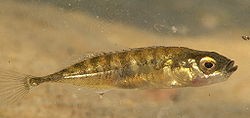- Ninespine stickleback
-
Nine-spined stickleback 
Pungitius pungitius Conservation status Scientific classification Kingdom: Animalia Phylum: Chordata Class: Actinopterygii Order: Gasterosteiformes Family: Gasterosteidae Genus: Pungitius Species: P. pungitius Binomial name Pungitius pungitius
(Linnaeus, 1758)Synonyms - Gasteracanthus pungitius (Linnaeus, 1758)
- Gasterosteus blanchardi Sauvage, 1874
- Gasterosteus burgundianus (non Blanchard, 1866)
- Gasterosteus concinnus Richardson, 1836
- Gasterosteus dekayi Agassiz, 1850
- Gasterosteus globiceps Sauvage, 1874
- Gasterosteus mainensis Storer, 1837
- Gasterosteus nebulosus Agassiz, 1850
- Gasterosteus occidentalis Cuvier, 1829
- Gasterosteus pungitia burgundianus (non Blanchard, 1866)
- Gasterosteus pungitius Linnaeus, 1758
- Gasterosteus pungitius brachypoda Bean, 1879
- Pungitius pungitius pungitius (Linnaeus, 1758)
- Pygosteus pungitius (Linnaeus, 1758)
- Pygosteus pungitius brachypoda (Bean, 1879)
- Pygosteus pungitius carinata Bertin, 1925
- Pygosteus pungitius semiarmata Bertin, 1925
- Pygosteus pungitius trachura Bertin, 1925
The ninespine stickleback (Pungitius pungitius), also called the ten-spined stickleback, is a freshwater species of fish in the Gasterosteidae family that inhabits temperate waters. Widely but locally distributed throughout the UK and along the Atlantic coast of North America, it is also found in many northern and eastern European countries, in Greenland and in Turkey, and in the Far East. Despite its name, the number of spines can vary from 8 to 12.
It lives in extremely weedy ditches and rivers as its small spines do not offer much protection. They have scutes or bony plates all the way down their body.
During the breeding season (April to July), the male develops a black belly and builds a nest suspended on a piece of waterweed, about an inch or so above the substrate at the bottom. The female is attracted over by the male and she lays eggs inside the nest. The male guards these eggs and the young fry when they hatch. Then when they have their spines he drives them away to look after themselves.
The colouring when not breeding is usually a dark brown, although females are a lot lighter cloured than the males. The male is normally chocolate brown with darker stripes and spots. His eyes are dark with a gold ring around his pupils, While on the three spined the eyes are silver. The female is more of a dark tan colour and has darker markings. It may have a silver belly and silver eyes. No two sticklebacks are the same; they are unique, just like human fingerprints. The body is a lot more elongated than the three spined stickleback with a thinner and longer caudal peduncal.
References
- Keivany, Y. 1996. Taxonomic revision of the genus Pungitius with emphasis on P. hellenicus. MSc thesis. Department of Biological Sciences, University of Alberta. Edmonton. 98 pp.
- Keivany, Y., and J.S. Nelson. 2000. Taxonomic review of the genus Pungitius, ninespine sticklebacks (Teleostei, Gasterosteidae). Cybium, 24(2): 107-122.
- Keivany, Y. and J.S. Nelson. 2004. Phylogenetic relationships of sticklebacks (Gasterosteidae), with emphasis on ninespine sticklebacks (Pungitius spp.). Behaviour, 141(11/12): 1485-1497.
- World Conservation Monitoring Centre 1996. Pungitius pungitius. 2006 IUCN Red List of Threatened Species. Downloaded on 5 August 2007.

This Gasterosteiformes-related article is a stub. You can help Wikipedia by expanding it.

